Click on images to enlarge
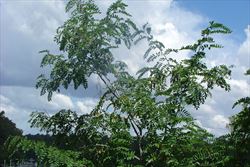
habit (Photo: Sheldon Navie)
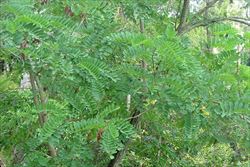
habit (Photo: Sheldon Navie)

rough furrowed bark on main trunk (Photo: Sheldon Navie)
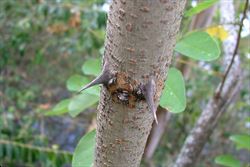
older branch with persistent pair of spines (Photo: Sheldon Navie)
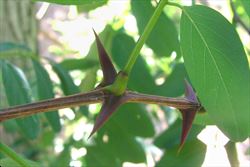
young branch with large spines present at the base of the leaf stalks (Photo: Sheldon Navie)

the large once-compound leaves (Photo: Sheldon Navie)
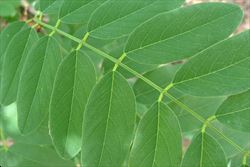
close-up of leaflets (Photo: Sheldon Navie)
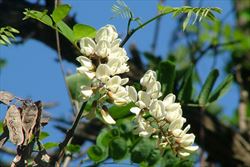
elongated drooping flower clusters (Photo: Sheldon Navie)
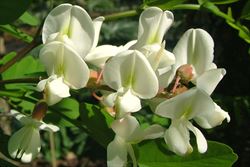
close-up of the white pea-shaped flowers (Photo: Sheldon Navie)

immature fruit (Photo: Sheldon Navie)
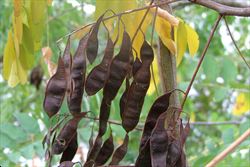
mature fruit and autumn foliage (Photo: Sheldon Navie)

close-up of mature fruit (Photo: Sheldon Navie)
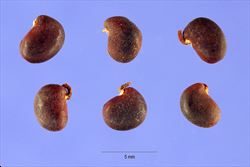
close-up of seeds (Photo: Steve Hurst at USDA PLANTS Database)
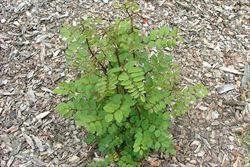
vigorous root suckers (Photo: Sheldon Navie)
Scientific Name
Robinia pseudoacacia L.
Family
Fabaceae (Queensland, the ACT, Victoria, Tasmania, and the Northern Territory)Fabaceae: sub-family Faboideae (New South Wales)Leguminosae (South Australia)Papilionaceae (Western Australia)
Common Names
black locust, black locust tree, false acacia, locust tree, post locust, robinia, white acacia, yellow locust
Origin
Native to eastern USA (i.e. Pennsylvania, Maryland, Virginia, West Virginia, Illinois, southern Ohio, south-eastern Indiana, Missouri, Tennessee, Kentucky, Arkansas, Oklahoma, Georgia, northern Alabama, North Carolina and South Carolina).
Cultivation
False acacia (Robinia pseudoacacia) is still common in cultivation, but most of these plants belong to one of the numerous modern cultivars and are distinct from typical plants present in naturalised populations. The modern cultivars are generally less invasive than the typical form of this species and the two most popular of these are golden locust (Robinia pseudoacacia 'Frisia'), with yellowish-green leaves, and mop top robinia (Robinia pseudoacacia 'Umbraculifera'). Other cultivars include 'Hillieri', 'Inermis', 'Lace Lady', 'Decaisneana' and 'Purple Robe'. Some of these cultivars are spineless (e.g. 'Inermis'), while others have pink or purplish flowers (e.g. 'Purple Robe').
Naturalised Distribution
Widely naturalised in southern and eastern Australia (i.e. in south-eastern Queensland, eastern and southern New South Wales, the ACT, many parts of Victoria, south-eastern and eastern South Australia and south-western Western Australia).
Also naturalised beyond its native range in the USA and in other parts of the world (e.g. Europe, northern and southern Africa, temperate Asia, New Zealand, Canada and southern South America).
Habitat
A weed of roadsides, disturbed sites, waste areas, gardens, riparian vegetation, urban bushland and open woodlands in temperate and sub-tropical regions.
Habit
A tree usually growing up to 10 m tall, but occasionally reaching up to 17 m in height. This species loses its leaves during winter (i.e. it is deciduous) and produces large numbers of suckers from its root system.
Distinguishing Features
- a tree that loses its leaves during winter and usually grows up to 10 m tall.
- it produces large numbers of suckers from its root system and eventually forms dense thickets.
- two broad spines (5-25 mm long) are present at the base of some or all of its leaves.
- its alternately arranged leaves are once-compound and have 11-21 oval or oblong leaflets.
- its white (occasionally pink or purple) pea-shaped flowers are arranged in elongated clusters (10-15 cm long).
- its elongated and flattened pods (3-8 cm long and 10-15 mm wide) turn brown as they mature.
Stems and Leaves
The bark on the main trunk of older trees is greyish and eventually becomes deeply furrowed. Two large spines (5-25 mm long) with broad bases (i.e. stipular spines) are present near the base of some or all of its leaves.
The alternately arranged leaves (8-15 cm long) are once-compound (i.e. pinnate) and borne on stalks (i.e. petioles) 14-45 mm long. These leaves have several to numerous (11-21) leaflets, which are borne on tiny stalks (i.e. petiolules) 1-3 mm long. The leaflets (2-6 cm long and 1-2.8 cm wide) are oval (i.e. elliptic) or oblong in shape with entire margins and rounded or slightly notched tips (i.e. obtuse or emarginate apices). They are hairless (i.e. glabrous) or sometimes sparsely hairy (i.e. puberulent) when young.
Flowers and Fruit
The pea-shaped flowers are arranged in elongated clusters (10-15 cm long) that are borne in the leaf forks (i.e. in axillary racemes). These flowers are predominantly white (occasionally pink or purple) and are borne on stalks (i.e. pedicels) 5-10 mm long. They have five hairy sepals (5-9 mm long) that are fused together at the base (i.e. into a calyx tube) and five petals (15-20 mm long). The uppermost petal (i.e. standard) is larger, often with some greenish markings at the base. There are also two side petals (i.e. wings) and two lower petals are fused together and folded (i.e. a keel). The flowers also have ten stamens, nine of which are fused to each other and one of which is separate, and an elongated ovary that is topped with a style and stigma. Flowering occurs mostly during spring and early summer (i.e. from September to December).
The fruit is an elongated and flattened pod (3-8 cm long and 10-15 mm wide) that turns from green to brown in colour as it matures. These fruit are hairless (i.e. glabrous) and split open when mature to release a few black or dark brown seeds.
Reproduction and Dispersal
False acacia (Robinia pseudoacacia) often reproduces by root suckers, which can arise spontaneously from the extensive fibrous root system even when the aboveground parts of the plant are undamaged. It also reproduces by seed are will re-spout vigorously from stumps that have been cut or damaged by fire.
Environmental Impact
False acacia (Robinia pseudoacacia) is regarded as an environmental weed in Victoria, the ACT, New South Wales, South Australia and Western Australia. During a recent survey, it was also listed as a priority environmental weed in at least one Natural Resource Management region.
Legislation
Not declared or considered noxious by any state government authorities.

